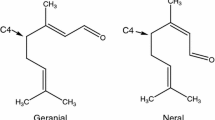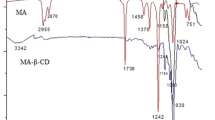Abstract
Encapsulation and release of carbon dioxide (CO2) into and from α-cyclodextrin (α-CD) was studied. Initial moisture content of α-CD and CO2 pressure were found to have affected the encapsulation behavior. The increase of CO2 pressure has constantly accelerated the encapsulation rates and increased the maximum inclusion ratio, whereas the increase of initial moisture content showed no consistent effect. The saturated α-CD solution produced the inclusion complex crystal of similar inclusion ratio to solid α-CD. The release characteristics of inclusion complexes were also monitored at various relative humidities at 25 °C. Predominantly, increase in storage humidity accelerated the release of CO2. The inclusion complex crystal prepared from saturated α-CD solution showed the most stable release characteristic at all storage humidities investigated. The encapsulation and the release characteristics were analyzed using the first-order reaction equation and the Avrami’s equation respectively, in order to estimate the rate processes of encapsulation and release. The FT-IR spectra of inclusion complexes presented an absorption band at wavenumber around 2338 cm−1, indicating CO2 molecules resided inside the α-CD cavities in gaseous state rather than being bound to the hydroxyl groups of α-CD. Powder X-ray diffractometry was carried out to investigate the crystal lattice structure of α-CD and inclusion complexes. Scanning electron microscopy was also performed for morphological examination.
Similar content being viewed by others
References
Rudkevich D.M., Leontiev A.V., Aust. J. Chem. 57, 713 (2004)
Hassonville S.H.D., Perly B., Piel G., Hees T.V., Barillaro V., Bertholet P., Delattre L., Evrard B., J. Incl. Phenom. Macrocyclic Chem. 44, 289 (2002)
Rawata S., Jain S.K., Eur. J. Pharm. Biopharm. 57, 263 (2004)
Yáñez C., Salazar R., Núñez-Vergara L.J., Squella J.A., J. Pharm. Biomed. Anal. 35, 51 (2004)
Kamada M., Hirayama F., Udo K., Yano H., Arima H., Uekama K., J. Control. Release 82, 407 (2002)
Cramer F., Henglein F.M., Chem. Ber. 90, 2572 (1957)
Atwood J.L., Barbour L.J., Jerga A., Angew. Chem. Int. Ed. 43, 2948 (2004)
Fenyvesi É., Szente L., Russell N.R., McNamara M., (1996) Specific guest types In Szejtli J., Osa T., (eds.), Comprehensive Supramolecular Chemistry Vol. 3: Cyclodextrin, Pergamon Press Oxford pp. 305–366
J. Daly and B. Kourelis: US Patent 6017849 (2000)
H. Yorozu, Y. Abe and Y. Eguchi: Japanese Patent S62–039602 (1987)
H. Yorozu, Y. Eguchi, W. Ohkawa, and Y. Matsumoto: European Patent EP0229616 (1987)
S. Rahman: Water Activity and Sorption Properties of Foods. In Food Properties Handbook, CRC Press, Boca Raton (1995), pp. 1–86
Saenger W., Steiner T., Acta Cryst. A 54, 798 (1998)
Nakai Y., Yamamoto K., Terada K., Kajiyama A., Sasaki I., Chem. Pharm. Bull. 34, 2178 (1986)
Klar B., Hingerty B., Saenger W., Acta Cryst. B36, 1154 (1980)
Saenger W., Noltemeyer M., Manor P.C., Hingerty B., Klar B., Bioorg. Chem. 5, 187 (1976)
Buschmann H., Schollmeyer E., J. Sol. Chem. 34, 731 (2005)
Yoshii H., Furuta T., Yasunishi A., Hirano H., J. Biochem. (Tokyo) 115, 1035 (1994)
Rehmann L., Yoshii H., Furuta T., Starch/Stärke 55, 313 (2003)
Graham B.F., Harrowfield J.M., Tengrove R.D., Lagalante A.F., Bruno T.J., J. Incl. Phenom. Macrocyclic Chem. 43, 179 (2002)
Yoshii H., Soottitantawat A., Liu X.D., Atarashi T., Furuta T., Aishima S., Ohgawara M., Linko P., Innov. Food Sci. Emerg. Technol. 2, 55 (2001)
Soottitantawat A., Yoshii H., Furuta T., Ohgawara M., Forssell P., Partanen R., Poutanen K., Linko P., J. Agric. Food Chem. 52, 1269 (2004)
Tasumi M., (1994) Basic and Practical Infrared Spectroscopy, 2nd Edition, Kagaku Doujin, Tokyo
Urbansky E.T., J. Environ. Monit. 3, 102 (2001)
Tanaka M., Ooba T., Toda S., (1964). Infrared Spectroscopy, Hirokawa Shoten, Tokyo
Keresztury G., Incze M., Sóti F., Imre L., Spectrochimica Acta 36A, 1007 (1980)
Author information
Authors and Affiliations
Corresponding author
Rights and permissions
About this article
Cite this article
Neoh, TL., Yoshii, H. & Furuta, T. Encapsulation and Release Characteristics of Carbon Dioxide in α-Cyclodextrin. J Incl Phenom Macrocycl Chem 56, 125–133 (2006). https://doi.org/10.1007/s10847-006-9073-6
Received:
Accepted:
Published:
Issue Date:
DOI: https://doi.org/10.1007/s10847-006-9073-6




